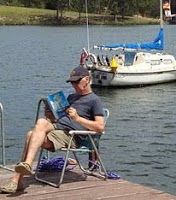
It is thirteen years ago almost to the day, when I received this email from someone who had lived an almost parallel life to mine, which prompted me to jot down the events that led to my going to Honiara in the Solomon Islands in February 1973 and my subsequent departure at the end of that same year:
| Hello Peter
Let me introduce myself: my name is Robyn Johnstone and I am a very happy 63 year old.
I feel comfortable addressing you as Peter as I am of the same vintage and I think we have lots of memories in common. How do I know this - because I have been reading your web page which I discovered last night during my Random Research.
I start reading on something that is of interest and the links take me on a wonderful journey. Last night I was seeking another copy of ‘Faraway’ as I gave my copy away to another old Solomon Island expat. From that point I reached ‘your footnote’ to “And thereby hangs yet another tale”. It was wonderful reading and I then went on reading other parts of your personal website. It was a joy to read.
My reason for reading about Pigeon Island is for me it was an ‘opportunity foregone’ [sic]. In about 1990 or 1991 I was asked by a friend (Ron Cross) who was promoting remote island tourism if I could house-sit for the owners who needed to go for a 6-week break to England. As I had 2 small children and a husband who worked for SIEA (an enterprise you are familiar with) I declined. Like so many other decisions in life it was a path not taken and still interesting to me 20 years later.
It was very interesting to read your life’s travels and view your pictures. It so reminded that once (10 years ago) an acquaintance at a party said, “I guess no one is really interested in your stories as they have never been to the places you have so why don’t you write them all down at least for your own memory sake.” I have yet to follow this advice but after reading your web page I might now be inspired.
Unlike you I was accompanying my husband who got the jobs on Pacific Islands so I had plenty of time to make friends and go to social gatherings while he worked. He was Deputy General Manager at SIEA (your BSIEA). We lived on Lengakiki Ridge in a house owned by SIEA with fabulous views of Iron Bottom Sound (there is a picture of this house on my Facebook). By the time he worked there, SIEA had bought up 40 houses for staff. Briefly we were there 1988-1993.
The house as photographed by Robyn Johnstone. I lived in the same house in 1973.
Now you know why I love your web page and so admire what you have contributed to my reading pleasure. Just like you I now read all the books that relate to the places we have lived. I am a great Somerset Maugham fan and I read Lucy Irvine and passed on the book Faraway to heaps of contacts.
I feel I know you from reading so much of your life on the web. Congratulations on your fabulously interesting offerings. I am on Facebook with lots of Solomon Island connections (you might know some).
Hope you enjoyed my little input and thank you for all the information and photos you provided for the pleasure and memory prompts for myself and others.
Regards to your wife Padma and yourself
Robyn Johnstone
|
What a parallel life: not only do Robyn and her husband now live in Townsville which had been my home in 1982, but she and her husband had also lived and worked in Samoa where I had worked in 1978, and in the Middle East where I had worked in 1982, and in Honiara where I had been the commercial manager of the same Electricity Authority for which her husband had been the Deputy General Manager many years later, and where they had lived in the very same house in which I had lived in 1973. You couldn't get more parallel than that!
Having assisted in the successful start-up of Camp Catering Services' operations on Bougainville in 1972, the company lured me to Sydney to become the group's Financial Controller. I hired a friend and fellow-accountant to take over from me and headed for Sydney - and disaster! Sydney was the pits! And it was agony to watch the financial achievements of the company's 'Jewel in the Crown' on Bougainville being frittered away in endless head office waste and infighting.
I quit after only five months. The managing director, Nelson Hardy, immediately offered me my old position back on Bougainville, but how could I do my friend out of a job? Instead, I found my own way back to the islands by successfully applying for the position of 'Secretary' (Commercial Manager) with the British Solomon Islands Electricity Authority (BSIEA) in Honiara, the capital of the then British Solomon Islands Protectorate.
I took over from another expat who for years had collected sizeable allowances for a non-existent wife and several children in Australia. When it seemed he was going to be found out, they all suddenly died in a car crash! Not that he shed a tear as such was the shortage of expat manpower that he was immediately re-employed by another business in town.
My new boss, the meek-and-mild General Manager of the Authority, a British civil servant 'Yes, Minister' type, wanted to get through his contract with a minimum of fuss and a maximum of benefits for himself and his cohorts of other expat time-servers whereas I was young and ambitious and wanted change. I hadn't read about Kipling's six honest serving-men yet but already couldn't help myself questioning the what and where and when and how and why and by whom when looking at some of the hide-bound Authority's procedures.
The warehouse at the old Honiara powerhouse (next to Blums' Hotel) documented the issue of every single bolt and nut and washer, worth no more than a few cents each, on triplicate requisitions. These were then priced, multiplied, totalled and entered on ledger cards TWICE, first on the respective stock card and then on the job card. As this work was deemed to be beyond the mental capacity of a 'Native', a highly-paid expat woman had made a career out of it. When I suggested that such minor material issues should be left unrecorded and instead a small lumpsum added to every capital job to account for such incidental issues, I was in her opinion hastening the decline of the British Empire! That she was the wife of a British police officer who had faithfully served the dying Empire, from one independence-gaining African colony to another, and now hung on to his last posting for dear life, was of course sheer coincidence. It was all jobs for the boys - and their wives!
The Authority employed a dozen Gilbert Islander meter-readers who lolled about the office for most of the time waiting for the end of the month when they were let loose like a swarm of angry bees to race through the streets and up and down the hills of Honiara to read the whole town's electricity meters all at once. They would then return to head office with their readings and, with the help of a calculator, deduct last month's reading from this month's, multiply the result by the kilowatt unit rate, and transcribe it all onto invoices which were then folded, put into envelopes, and mailed out.
After having watched this in utter amazement for the first month, I suggested that the town area should be broken up in sectors and that meters should be read throughout the month, each sector at the same time each month. I also suggested that, with each kilowatt hour costing just a few cents, consumption should be charged in multiples of TEN kilowatts so that meter-readers could drop the last digit on their readings to make the recording of this month's and the deducting of the previous month's reading easier. Finally, I drew up a simple ready reckoner of charges in multiples of ten kilowatts for the meter-readers' use. They would take it with them on their rounds together with each householder's invoice on which the previous month's reading (without the last digit) had already been carried forward. As they read the meter, they would enter the new reading (without the last digit), deduct the previous month's reading, look up the charge on the ready reckoner, and enter the dollar amount on the invoice. The original invoice would then be left in the householder's mailbox and the carbon copy (yes, they had already progressed to NCR-type precarbonised invoice paper) returned to the office.
All hell broke loose! This would never do! Surely, those 'black savages' couldn't do a white man's job? I had rocked the British expats' lifeboat, HMS Sinecure, and it was all hands on deck to repel the usurper from the Colonies!
Well, it took me longer to convince the Protectorate's Auditor-General, who had been roped in to stop me from committing these follies, than to train the meter-readers who welcomed the changes with full throttles as they zoomed all over town, proud of their new importance. To paraphrase Lawrence of Arabia, "It is better that they do a thing imperfectly than for you to do it perfectly: for it is their country, their work, and your time is limited".
 Wednesday nights was Chess Night on the terrace of the Mendana Hotel
Wednesday nights was Chess Night on the terrace of the Mendana Hotel
 there was always a big do on of a Saturday night at the Guadalcanal Club
there was always a big do on of a Saturday night at the Guadalcanal Club
(commonly referred to as G-Club)

My house on Lengakiki Ridge overlooking Honiara and the sea
I lived a gracious life in a big house on Lengakiki Ridge overlooking Honiara and the ocean beyond, all the way to Savo Island and Tulagi. I was member of the Point Cruz Yacht Club and every day by 4.30 sharp the offshore breeze would fill the sails of my CORSAIR dinghy. Wednesday nights was Chess Night on the terrace of the Mendana Hotel and there was always a big do on of a Saturday night at the Guadalcanal Club (commonly referred to as G-Club).
 Entrance to the Governor's Residence
Entrance to the Governor's Residence
New arrivals in the Protectorate were supposed to leave their card with the aide-de-camp to His Excellency the British Governor. In due course, a gold-embossed invitation would be hand-delivered to summon them to morning tea on the lawns of the Governor's Residence.
Some of those 'Empire-builders' actually did walk with their noses in the air. They may have suffered from a rare medical condition that necessitated keeping their nostrils uplifted - if so I'm sorry for them - but the impression they gave me was that of the snooty Englishman abroad.
I was bored by the ease and comfort and meaninglessness of it all. Those were my restless years and I still had places to go - more than thirty, as it turned out - so, unable to tuck another cucumber sandwich under the cummerbund, this subject left Her Brittanic Majesty's Protectorate to return to reality (spelled PNG, then Burma, Iran, again PNG, Thursday Island, Samoa, Malaysia, Saudi Arabia, Greece, etc etc).

Googlemap Riverbend

 Yours truly on the left
Yours truly on the left






























